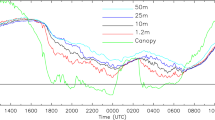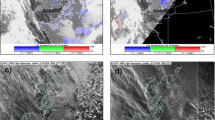Abstract
—A simple one-dimensional numerical-analytical model was developed by Meyer and Rao (1995) to predict the onset of radiation fog. The model computes radiative cooling and turbulent diffusion of heat and vapor through the lower boundary layer and produces heat and vapor fluxes at the soil–atmosphere interface. The model is designed for Air Force forecasters who have access to a personal computer, an early evening surface observation of the dry bulb and dewpoint temperature, wind speed, the lapse rate in the upper boundary layer, and the previous 24-h precipitation amount. These initial data are used to predict the diurnal variation of the dry bulb and dewpoint temperatures at 10 m above the surface. In accordance with conventional synoptic observing practices, fog is defined as a restriction of the surface visibility generally to less than 1000 m. Fog is assumed to occur in the model predictions when the dewpoint depression falls to less than 1°C. Observations, from several Air Force bases for selected days when fog was observed to occur, were used to test the model. The present model with default parameters appears to predict the onset of fog slightly ahead of its occurrence. Better verification results are expected when site-relevant parameters are used in model predictions.
Similar content being viewed by others
Author information
Authors and Affiliations
Additional information
Received June 16, 1998, accepted January 20, 1999.
Rights and permissions
About this article
Cite this article
Meyer, W., Rao, G. Radiation Fog Prediction Using a Simple Numerical Model. Pure appl. geophys. 155, 57–80 (1999). https://doi.org/10.1007/s000240050254
Issue Date:
DOI: https://doi.org/10.1007/s000240050254




